Heading out the door? Read this article on the new Outside+ app available now on iOS devices for members! Download the app.
What Californians have long known as fire season is now a phenomenon that has grown to epic proportions as a result of climate change. The apocalyptic images of flames raging in the West are now alarming people far beyond California’s borders.
While it’s easy to demonize fire, it’s also important to remember that humans have long relied on its transformational power. Learning to harness light and heat has helped us to stay warm, feed our families, and ward off dangers in the darkness. Without fire, we would not have survived or evolved.
There is a delicate balance to working with flames; a fire can be intense and wild, or it can be weak—more smoke than heat. Managing it requires a skillful equilibrium: a single spark to get it started, enough fuel to keep it sustained, and boundaries to prevent it from blazing out of control.
Building a sustainable yoga practice is similar. Teachers and practitioners often think of Tapas (the burning away of impurities) as something to help light a fire within—and understandably so, considering the word is derived from the Sanskrit root tap, which means “to heat.” But Tapas is about so much more than building strength and stamina. It’s also about having the mental discipline to find the middle ground between pushing yourself and relaxing; it’s about not overdoing it in your asana practice to the point of burnout or injury, but rather learning to listen to what your body is telling you in each pose to find a deeper connection with yourself.
This yoga sequence is designed to cultivate equilibrium both on the mat and off. These anchoring, centering poses aren’t all typical Tapas-building postures. While some may seem simple, they may be challenging to hold. Explore the balance between how much effort and effortlessness you can experience in each one. Learning to discover that happy medium in your asana practice will help you tap into your determination while also sustaining your energy. It will also help you hone your focus, and it should be fun!
Start with a few rounds of Sun Salutations to warm up your body and center your mind before beginning the sequence. The goal is not to build so much heat that you start to resemble an uncontrolled wildfire, but rather to stoke your inner flame just enough to find the sweet spot where you feel balanced, steady, and at ease.
Kapalabhati (Breath of Fire)
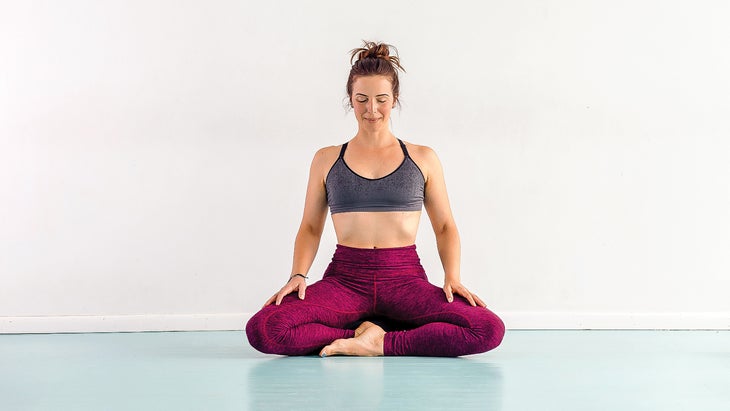
Sit in Sukhasana (Easy Pose) with your lips closed. Breathe in through your nose to about half of your lung capacity. Maintaining expansion in your ribs, sharply contract your lower belly to push quick bursts of air out through your nose. Release 20–50 short exhalations.
Tadasana (Mountain Pose)
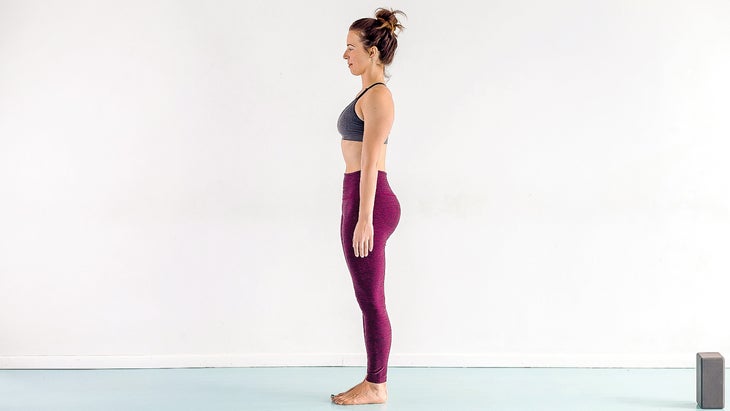
Stand with your feet hip-width apart, spreading your toes wide. Engage your legs, lift your kneecaps, and firm your lower abdomen. Press your shoulders back slightly to broaden your chest; allow your arms to lengthen at your sides. Soften your jaw, and allow your chin to tilt slightly down to lengthen the back of the neck. Hold for 5 breaths.
Vrksasana (Tree Pose)
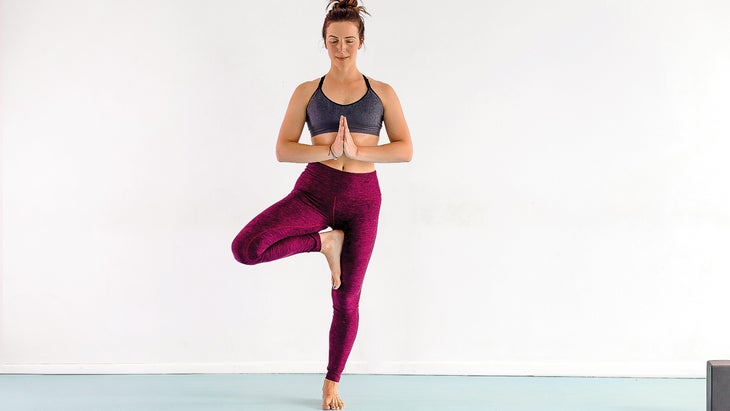
From Mountain Pose, turn your right leg out about 45 degrees and lift that foot up to rest either above or below your left knee. Press your palms together in front of your chest and engage your core. Hold for 10 breaths. Return to Mountain Pose. Repeat on the other side.
Uttanasana (Standing Forward Bend)
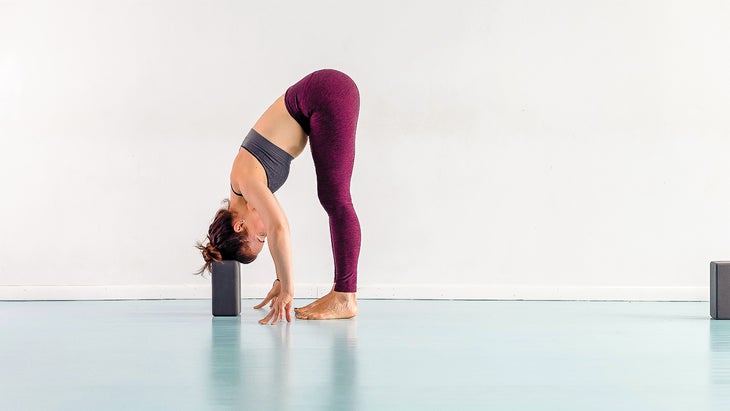
From Mountain Pose, fold forward, hinging at your hip joints (not bending at your waist). Place one or two blocks under the top of your head. Place your hands on the floor or on blocks, shoulder-width apart. Hold for 5 breaths.
Plank Pose
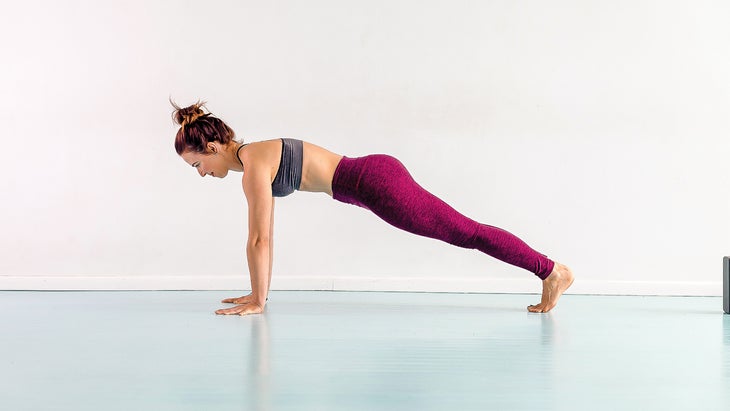
From Standing Forward Bend, remove any props. Place your hands under your shoulders, then walk your feet back until your body is fully extended, legs straight and abdominals engaged. Firm your thighs and lift your knees. Press up, keeping your chest broad and lengthening the back of your neck. Hold for up to 20 breaths.
Ado Mukha Svanasana, Variation (Downward-Facing Dog)
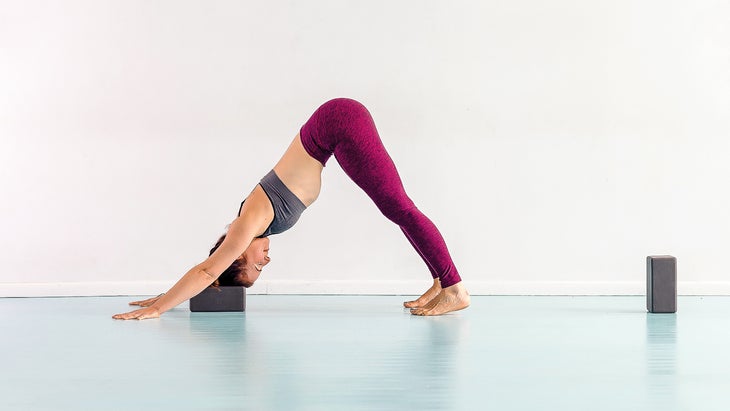
From Plank Pose, hinge at your hips, lifting your buttocks to move your body into an upside-down V shape. Press down evenly through both hands and feet. Support your head with a block on its lowest height. Hold for 10 breaths.
Balasana (Child’s Pose)
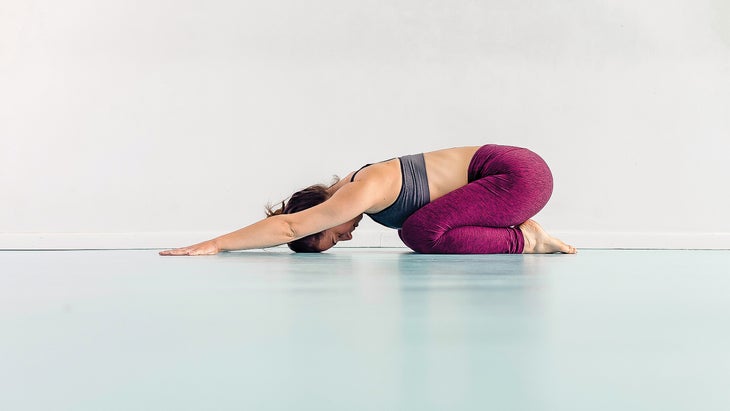
From Downward-Facing Dog, release your knees to the floor, and press your hips toward your heels, resting your torso on your thighs. Stretch your arms forward, palms down, and soften your shoulders. Rest your head to the ground, or place a block under your forehead. Hold for 5 breaths.
Sukhasana, Variation (Easy Pose)

Come to a seated position, crossing your shins so your feet are directly below your knees. Place one or two blocks 6–12 inches in front of you. Hinge at your hips and lean forward, resting your forehead on the blocks. Soften your face and jaw. Hold for 5 breaths.
Paschimottanasana, Variation (Seated Forward Bend)
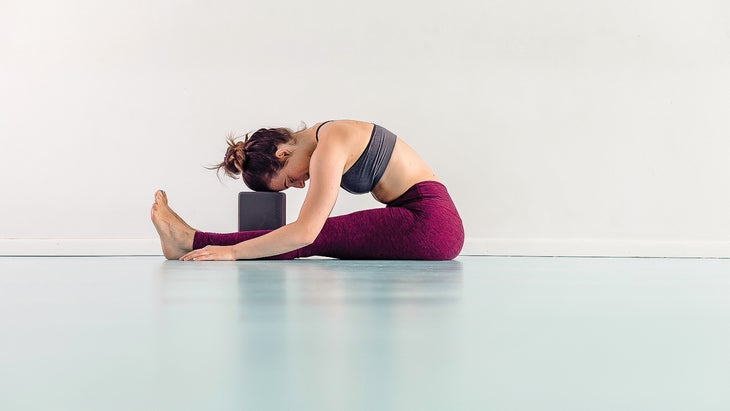
Extend your legs forward, separating them slightly (but not quite hip-width apart). Stack one or two blocks on their narrowest width between your legs. Fold forward and rest your head on the blocks. Soften your neck, face, and jaw. Hold for 5 breaths.
Savasana, Variation (Corpse Pose)
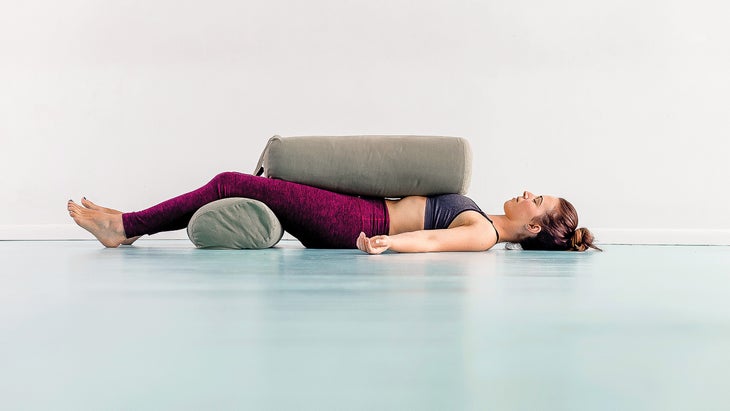
Lie back onto your mat and place a bolster or rolled towel or blanket under the bend of your knees. Place another bolster lengthwise on top of your body to help you relax deeply and feel grounded. Release your arms to your sides, palms up. Allow your body to become heavier and softer. Rest here for 5 minutes or longer.
Sarah Girard began her wellness journey when she was diagnosed with a rare eye cancer at the age of two, spending much of her childhood in and out of the hospital. She has accrued over 1,000 yoga educational credits and has led more than 10,000 hours of public, corporate, and one-on-one sessions over the past 15 years. She believes that by connecting to our creativity, mindfulness, and movement we can unlock our pathways to healing. Learn more at sarahgirardyoga.com.
Practice online with Sarah at yogajournal.com/sarahgirard.
From March/April 2021